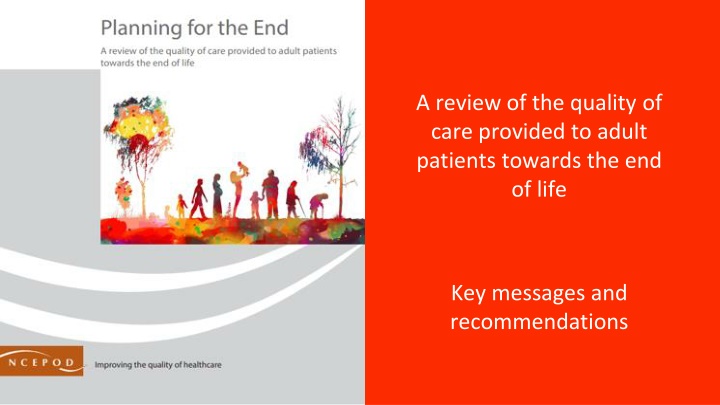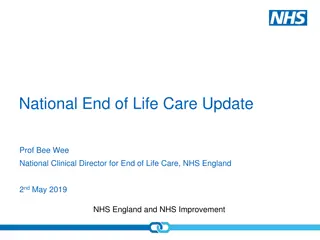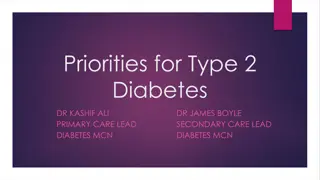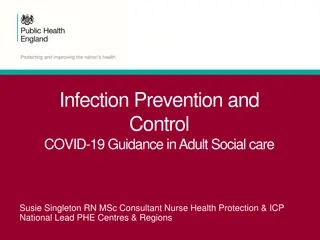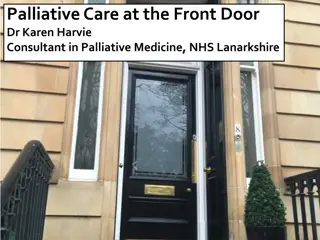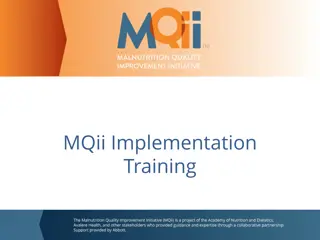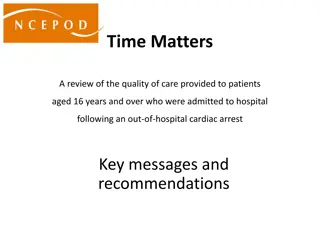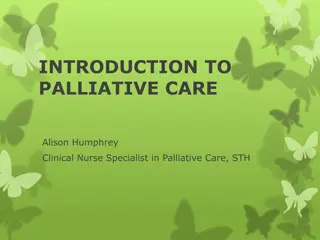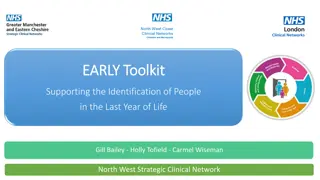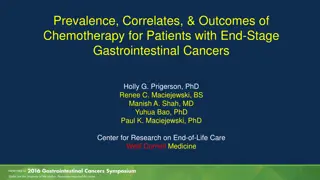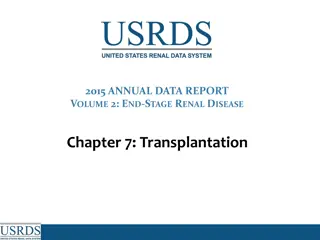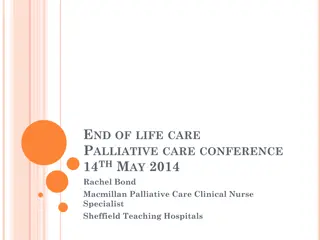Quality of End-of-Life Care for Adult Patients: Key Messages and Recommendations
This review focuses on the care provided to adult patients towards the end of life, highlighting key messages and recommendations. It discusses the need for early palliative care, normalization of conversations about death and dying, and areas for improvement in communication and care planning. The study includes data from patients with conditions like dementia, heart failure, lung cancer, and liver disease, emphasizing the importance of addressing end-of-life care needs.
Download Presentation

Please find below an Image/Link to download the presentation.
The content on the website is provided AS IS for your information and personal use only. It may not be sold, licensed, or shared on other websites without obtaining consent from the author.If you encounter any issues during the download, it is possible that the publisher has removed the file from their server.
You are allowed to download the files provided on this website for personal or commercial use, subject to the condition that they are used lawfully. All files are the property of their respective owners.
The content on the website is provided AS IS for your information and personal use only. It may not be sold, licensed, or shared on other websites without obtaining consent from the author.
E N D
Presentation Transcript
A review of the quality of care provided to adult patients towards the end of life Key messages and recommendations
The Study Study population: Patients aged 18 or over who died in hospital between 1st April 2022 and 30th September 2022 with one or more of these conditions: dementia, heart failure, lung cancer or liver disease. A sample of people who died in the community was also identified. Data sources: Clinician questionnaires Case reviews Organisational questionnaires data provided by NACEL
Study population Inclusion criteria : Patients aged 18 or over who died in hospital between 1st April 2022 and 30th September 2022 with one or more of the following conditions: dementia, heart failure, lung cancer or liver disease. A sample of people who died in the community was also identified. These were patients admitted to hospital during the study period with one of the included diagnoses who were subsequently discharged and died within six-months. Exclusions: Death due to suicides, homicides, or self-harm related Death due to trauma, drowning, drug overdose or poisoning
1 PALLIATIVE CARE IS NOT JUST ABOUT END OF LIFE CARE Not enough patients had access to early palliative care alongside existing treatments to improve symptoms and quality of life 135/439 (30.8%) patients had parallel planning. During the final admission, the specialist palliative care team were involved in the care of 230/446 (51.6%) patients. Where a parallel planning approach was not taken, this linked to room for improved clinical care for 58/140 (41.4%) patients.
2 NORMALISE CONVERSATIONS ABOUT DEATH AND DYING Death and dying was not discussed as often as it could have been. More people need to have their end of life care wishes recorded. 169/233 (72.5%) patients did not have their preferences for care at the end of their life recorded. Communication was an area for improvement and of good practice. This included how patients and their families were included in decisions about care being provided, and advance care plans.
3 HAVE A NAMED CARE-CORDINATOR Care co-ordinators are an accepted standard in cancer services but were less common for other advanced chronic conditions. There was documentation of a lead person in the records of 257/396 (64.9%) patients. When a lead person was documented, specific end of life documentation was used in 162/243 (66.7%) patients, compared with 44/134 (32.8%) where there was no lead person documented.
PROVIDE SPECIALIST PALLIATIVE CARE SERVICES IN HOSPITALS AND IN THE COMMUNITY 4 Specialist palliative care services were not always available in hospitals nor involved when needed. Seven-day specialist palliative care services were available in 125/210 (59.5%) hospitals. 120/290 (41.4%) patients without parallel planning had specialist palliative care input, compared with 94/130 (72.3%) who did. For 77/444 (17.3%) patients specialist palliative/end of life care input could have been better.
5 PALLIATIVE AND END OF LIFE CARE SHOULD BE A CORE COMPETENCIES Training to identify when palliative or end of life care will help was not always provided or available. Training in end of life care was included in the induction programme in only 137/214 (64.0%) hospitals and in mandatory or priority training in 110/214 (51.4%) hospitals. Training in end of life care for all patient-facing healthcare staff is needed to recognise who would benefit from specialist palliative care to treat the symptoms of advanced chronic disease.
Parallel planning in advanced chronic conditions Ensure that patients with advanced chronic disease have access to palliative care alongside disease modifying treatment (parallel planning) to improve symptom control and quality of life. Primary target audience: Integrated care boards and commissioners, hospital executive boards Supported by: Palliative care services, clinical directors, medical directors and directors of nursing, hospice services and local authorities, primary care, community care including care homes, nursing homes and social care This aligns with NICE Guideline [NG142], End of life care for adults: service delivery, 2019
Communication about death and dying Normalise conversations about palliative/end of life care, advance care plans, death and dying. As a trigger to introduce a conversation which includes the patient and their family/carers, consider: The surprise question Would you be surprised if this patient died within the next 12-months? This can be used across all healthcare settings; and/or Recurrent hospital admission of patients with advanced chronic disease. Primary target audience: Patients and their families/carers, all healthcare professionals, specifically members of the clinical team treating the underlying disease, primary care, community care including care home and nursing home staff Supported by: Palliative care services, clinical directors, medical directors and directors of nursing, hospice services and social care
Named care co-ordinator Ensure all patients with an advanced chronic disease are allocated a named care co- ordinator. Primary target audience: Medical directors and directors of nursing in integrated care boards, health boards and trusts Supported by: Palliative care services, clinical directors, primary care, hospice services and social care This aligns with NICE Cancer Service Guideline [CSG4] Improving Supportive and Palliative Care for Adults with Cancer
Specialist palliative care services provision Provide specialist palliative care services in hospitals and in the community, to ensure all patients, including those with non-malignant diseases receive the palliative care they need. Primary target audience: Integrated care boards and commissioners Supported by: Medical directors, directors of nursing, the Association for Palliative Medicine of Great Britain and Ireland, hospice services, primary care, and community care This aligns with recommendations from the National Audit of Care at the End of Life
Training for patient-facing healthcare professionals Train patient-facing healthcare staff in palliative and end of life care. This training should be included in: Undergraduate and postgraduate education; and Regular training for patient-facing healthcare staff Primary target audience: Medical schools, schools of nursing and university departments who provide training for nurses, pharmacists, allied health professionals, primary care, community care including care homes, nursing homes, social care, post-graduate deaneries, medical directors and directors of nursing Supported by: Executive boards, integrated care boards and commissioners, Care Quality Commission, Health Inspectorate Wales, Regulation and Quality Improvement Authority Northern Ireland This aligns with recommendations from the National Audit of Care at the End of Life
Advance care plans Ensure that existing advance care plans are shared between all providers involved in a patient s care. This aligns with recommendation 2 from the NCEPOD report looking at the in-hospital care of out of hospital cardiac arrests Time Matters Primary target audience: Integrated care boards and commissioners Supported by: Palliative care services, clinical directors, medical directors and directors of nursing, primary care, ambulance trusts, care home and nursing home providers, hospice services, social care, local authorities, patients, carers and family members
Public awareness Raise public awareness to increase the number of people with a registered health and welfare lasting power of attorney (LPA) well before it is needed. Primary target audience: Department for Health and Social Care, Welsh Government, Department of Health Northern Ireland, Office of the Public Guardian, the Office of Care and Protection Supported by: Royal colleges, patient support groups, third sector organisations, hospice services, primary care, community care including care homes, nursing homes and social care
REPORT and TOOLS http://www.ncepod.org.uk/2024eolc.html Report Summary Infographic Recommendation checklist Audit tool Driver diagram Fishbone diagram Commissioners guide
